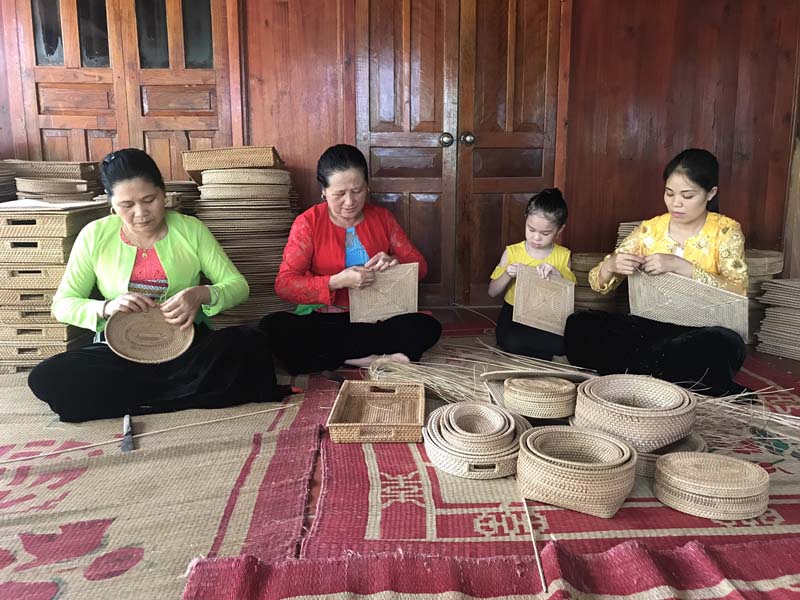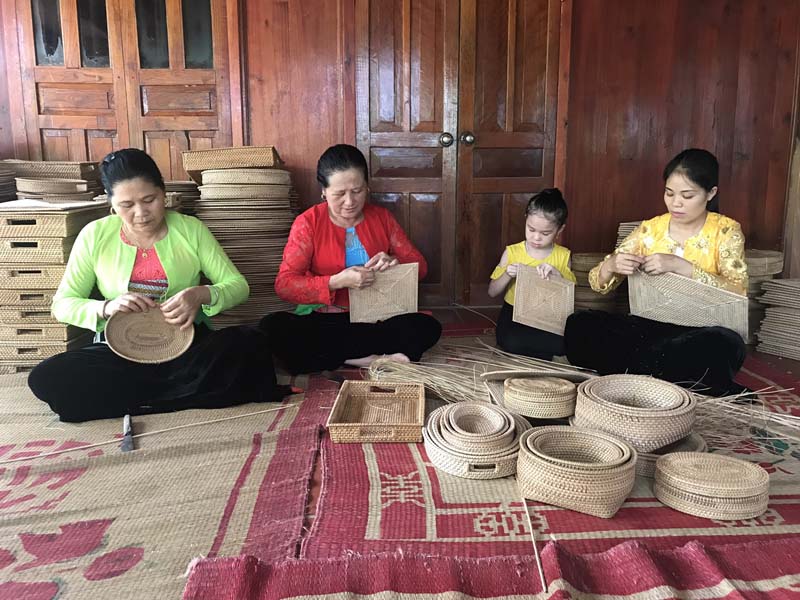
(HBO) - Rattan and bamboo weaving in Bui hamlet of Nhan Nghia commune (Lac Son district) dates back hundreds of years. Over generations, local craftsmen have always worked hard to ensure sophistication and uniqueness of each product.
Bamboo weaving sustained in Bui hamlet.
Well aware of the importance of the trade to economic
development and cultural identity conservation, local authorities have been
striving to gradually revive this traditional craft, thereby helping to reduce
poverty, improve income and create jobs for rural residents.
The rattan and bamboo craft village of Bui
hamlet, officially recognised on December 17, 2017, is providing stable jobs
for more than 350 locals with an average per capita income of 2 – 3 million VND
(86.4 – 129.5 USD) each month. It has been operating fruitfully, producing
items, mostly handmade, with diverse designs and ensured quality. As a result,
local products have won preference in the market, and the village has received
a number of big orders from across Vietnam, as well as other countries like
China and Japan.
Quach Thi Dung, head of the rattan and bamboo
craft village of Bui hamlet said: "This traditional craft village dates back to
a long time ago, but it used to fall into oblivion. I and other people have
strived to revitalise the traditional craft. The first steps were very
difficult, but thanks to the support of authorities of all levels, the rattan
and bamboo craft village was set up. It has attracted 170 households with over
350 workers to producing rattan and bamboo items. There remain numerous
difficulties in production development such as those relating to materials,
kilns, bleaching facilities, cutting machines and other equipment. We hope that
authorities will create more favourable conditions for the village to further develop.”
In the face of changes in the modern life,
rattan and bamboo weaving was sometimes thought to be unable to survive. Thanks
to their enthusiasm and dedication, the skilled craftsmen have been determined
to maintain this craft with the hope of seeking a firm foothold for it.
Bui Thi Thu Dung, a member at the rattan and
bamboo craft village of Bui hamlet said: "I began making rattan and bamboo
items when I was a small girl. My grandmother and mother taught me this craft.
I weave products to make use of my spare time and also raise my family’s
income.”
It takes craftsmen lots of steps and meticulousness to create a rattan and bamboo
item. Through their skilful hands, simple materials are transformed into fine
and colourful products imbued with cultural identities.
In the past, rattan and bamboo goods were made
mainly to serve daily needs of families. Recently, authorities of Nhan Nghia
commune have organised training courses to help craftsmen create new products
to meet the market’s rising demand such as flower baskets, lampshades or candy
containers with diverse designs.
Bui Duc Ngu, Chairman of the People’s Committee
of Nhan Nghia commune said: "Rattan and bamboo weaving has greatly contributed
to socio-economic development of the commune because it is a local traditional
craft which every people, from the elderly to teenagers, can practice, thus
helping to improve their income during their idle time. More and more people
have engaged in this craft.”
To maintain the rattan and bamboo weaving craft
of Bui hamlet, it is necessary to continue improving craftsmen’s skills, equip
them with modern machinery to better product quality and design, expand the
market and enhance products’ competitiveness so that the traditional craft is
conserved and developed, and the standing of traditions is further consolidated
in the modern life./.
With an increasingly vibrant and widespread emulation movement aimed at building cultured residential areas and cultured families, Yen Thuy District has been making steady progress toward improving both the material and spiritual well-being of its people, while fostering a civilized, prosperous, beautiful, and progressive community.
Once lacking recreational spaces and community facilities, Residential Group 2 in Quynh Lam Ward (Hoa Binh City) has recently received attention for the construction of a new, spacious, and fully equipped cultural house. The project followed the model of state support combined with public contributions in both labor and funding.
The "All people unite to build cultural life" movement, which has been effectively integrated with Kim Boi district’s socio-economic development goals, is fostering a lively spirit of emulation across local residential areas, hamlets, villages, public agencies, and enterprises. In addition, through the initiative, traditional cultural values are being preserved and promoted, while community solidarity and mutual support in poverty reduction and economic development are being strengthened.
A working delegation of the Hoa Binh provincial People’s Committee led by its Permanent Vice Chairman Nguyen Van Toan on June 11 inspected the progress of a project to build the Mo Muong Cultural Heritage Conservation Space linked to tourism services in Hop Phong commune, Cao Phong district.
Born and growing in the heroic land of Muong Dong, Dinh Thi Kieu Dung, a resident in Bo town of Kim Boi district, in her childhood was nurtured by the sweet lullabies of her grandmother and mother. These melodies deeply imprinted on her soul, becoming an inseparable part of her love for her ethnic group's culture. For over 20 years, this love for her hometown has driven Dung to research, collect, and pass down the cultural values of the Muong people to future generations.
In the final days of May, the Ethnic Art Troupe of Hoa Binh Province organized performances to serve the people in remote, mountainous, and particularly disadvantaged areas within the province. These were not just ordinary artistic shows, but they were the meaningful journeys aimed at spreading cultural values, enhancing the spiritual life of the people and contributing to the preservation of ethnic minority cultural identities.



